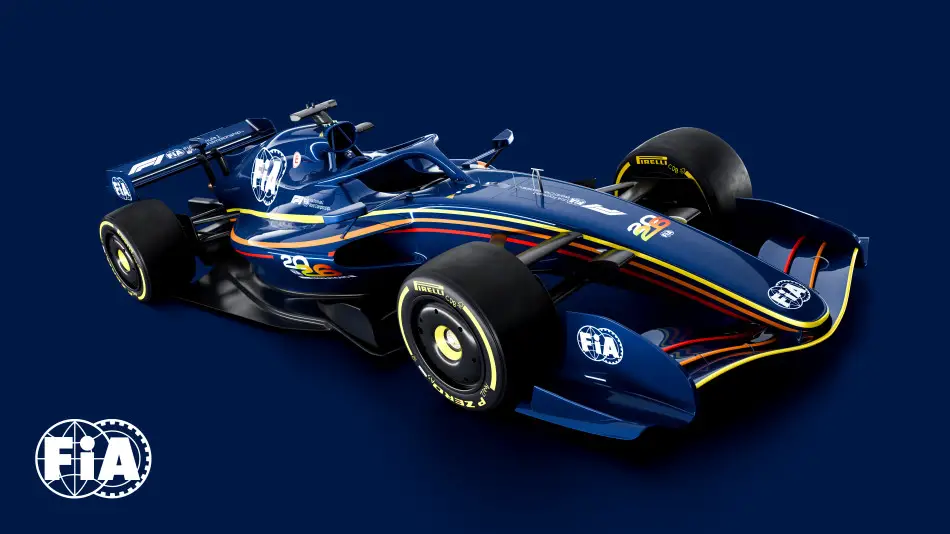FIA announced the new F1 regulations for 2026 in detail ahead of the Canadian MP. Here are all the technical regulations. Are the new rules an advantage for Mercedes?
Formula 1 will be radically transformed from the 2026 season onwards, and the purpose for which the new rules have been created refers to sustainability, safety, and the use of cutting-edge technologies that all lead to a more engaging spectacle. Let’s discuss them one by one.
Propulsion
The FIA’s aim was for almost 50% of power to be electric, and this decision led to radical changes. MGU-K electric motor connected to the crankshaft of the combustion engine provided 120 kW before, and now it will provide 350 kW, which is almost three times more. The main question is how to charge the battery enough to power such a powerful electric motor.
From 2026, the ICE engine will develop around 400 kW (545 PS) and the MGU-K electric motor another 350 kW (475 PS), making a total of 1020 PS with a 100% charged battery. The boost pressure of the turbo has been limited to 4.8 bar, and the compression ratio has been reduced from 18:1 to 16:1 to limit the power of the ICE engine.
At the same time, the MGU-H unit has been dropped because is no longer needed, as the ICE engine power has been considerably reduced. The MGU-H is placed between the exhaust gas turbine and the compressor wheel, directly on the turbine shaft. This technology was used by Mercedes for the Mercedes-AMG One hypercar.
It will be interesting to see if Mercedes’ battery and battery power management expertise will help the German carmaker achieve greater efficiency in energy recuperation and battery charging.
Dimensions and weight
The new Formula 1 cars will be lighter and more compact. The wheelbase has been reduced from 3,600 to 3,400 mm, the width of the car has been reduced from 2,000 to 1,900 mm, the front wing is 100 mm narrower and the wheels remain 18-inch but the width of the tires has been reduced by 25 mm at the front and 30 mm at the rear. Only two flaps are allowed at the front and three at the rear. The floor width has been reduced by 150 mm and it will be flat over a larger area, with the rear diffuser less aggressive. All these measures will minimize downforce by 30% and drag by 55% to make the electric motor more efficient.
The car’s weight has been reduced by 30 kg, from 798 to 768 kg. The weight consists of 722 kg car weight and 46 kg wheels and tires.
The DRS will be replaced by a new system. In order not to slow down on the straight lines, because full throttle is needed where possible to charge the battery, there will be active aerodynamics for the first time in Formula 1. At the push of a button, the front wing and rear wing will be oriented perfectly horizontally for minimum drag. As with the DRS system, the driver will receive an acoustic signal to activate X-mode for minimum drag.
Mercedes has also a high expertise in the area of active aerodynamics used in series production for the AMG One Hypercar and for the new AMG SL and AMG GT.
For the show, the FIA has developed a new system that will make overtaking more spectacular. It’s an extra boost known as ‘Manual Override’ which allows the driver to access extra electrical power for a lap if he is close to a rival and he is preparing to overtake. The extra electric power is only available from 290 km/h upwards.
The rules in the figures
Propulsion
F1 regulations for 2026 in figures
Engine: V6 at 90 degrees
Displacement: 1,600 cc
Supercharging: turbo
Maximum bore: 80 mm
Maximum compression: 16:1
Maximum boost pressure: 4.8 bar
Maximum engine speed: 15,000 rpm
Maximum turbine speed: 150,000 rpm
Fuel: E100
Tank capacity: 100 kg (approx. 135 litres)
ICE engine power: approx. 400 kW (545 PS)
Maximum energy flow: 3,000 MJoule/h
Electric motor: MGU-K
Electric motor power: approx. 350 kW (475 PS)
Maximum torque MGU-K: 500 Nm
Energy in battery: 8.5 MJoule/stroke
Extra Boost: 350 kW from 290 km/h to 337 km/h
Minimum weight of the entire propulsion system: 185 kg
of which ICE engine, turbocharger, power electronics: min. 130 kg
Turbocharger: min. 12 kg
MGU-K: min. 16 kg
Output shaft: min. 4 kg
Battery: min. 35 kg
Units allowed/pilot/year
a) 3 thermal engines, 3 turbochargers, 3 exhaust systems
b) 2 batteries, 2 MGU-K
Bench test hours allowed in 2026: 700 h (ICE engine), 500 h (electric engine).
Budget allowed: $130 million per year from 2026 onwards
Body
Wheelbase: max. 3,400 mm
Width: max. 1,900 mm
Minimum weight: 768 kg including driver
DRS: front and rear wing
Rear wing: 3 elements, adjustable
Front wing: 2 flaps, adjustable
Wheels: 18-inch
Tyre width: 705 mm (front), 710 mm (rear)
Podea: Almost entirely paid
Diffuser: less aggressive
Deflectors: Deflector in front of the side sills replaces the front spoiler

Comments are closed